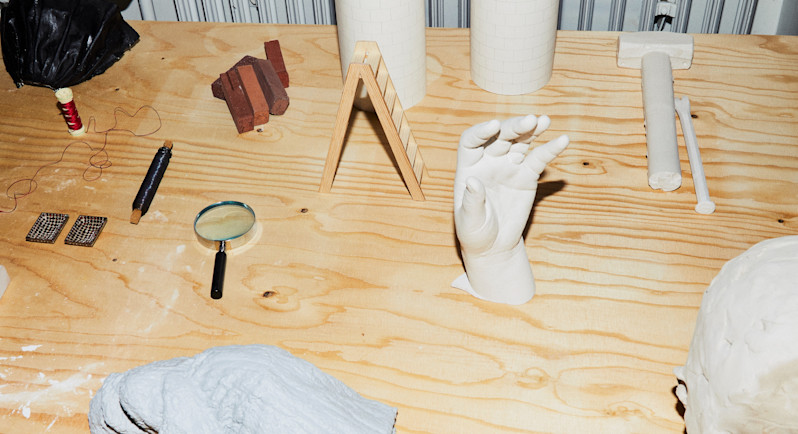Charlotte Gyllenhammar — “Where language ends, image begins.”
Interview
February 10, 2022
- Paulina Sokolow

She is a philosopher of three-dimensionality, a thinker who finds her way between different points in time and space, in a world of ideas in which that which is indivisible, or solid, in terms of its meaning is given particular consideration. This has granted her oeuvre certain characteristic attributes, which have recurred in different variations, with small shifts and distortions over the decades. The child, upside-down-ness, positive and negative shapes, and a distinctive way of lending form, a material quality, to time. Charlotte Gyllenhammar talks to Paulina Sokolow about the exhibition Believe My Eyes.
We meet in one of her studios, a few weeks before opening night. I have followed her work since 1993’s Dö för dig [Die for You], the upside-down oak tree that she suspended over Drottninggatan, like a strike of lightning, frozen in time, hovering over the shoppers. In a way, everything was in place right from the beginning. The universal symbols, the minimal gestures, and the charging of a single object. Solitaires, seemingly sealed to us, which activate the air around them, triggering mental chain reactions. I’m fascinated by the stamina she’s been showing for more than three decades now. How has she managed to keep her world intact, and discover new life in there, time and time again? And how did it all begin? We’re sitting in a small studio in Frihamnen.
— I work in clay and plaster, and that can get very dusty. That’s why I keep two studios. In this one, I work with photography and montage, so it’s a lot tidier and cleaner here.
The first thing I notice is unexpected: a newly opened box of unused pastel crayons, in bright, loud colours.
— Yes, the kind they gave you in school. They bring back memories. This particular brand, I loved them. These days, though, I only use the red ones. I’ve become very restrained when it comes to the use of colour. Back when I was admitted to Mejan, I used a lot of very strong colours. But now, choosing a colour seems like such a statement; I end up wanting to handle just a single colour at a time. Things are a certain colour; I don’t colour them. When I began making small-scale sculptures, I visited the sculpture workshop on Skeppsholmen. You know, it was all very divided back then, and your genre, your teacher, and your physical location all defined you to a great extent.
We were a group from painting who went to sit at this big table in the workshop. The sculpture students thought we were such dorks. They were all pretty macho, with their talk of monoliths, pieces of iron, weights, and kinds of rock, while we were there at the table doing what must have seemed like children’s crafts to them. I stayed there in the workshop, painting on my sculptures, even on the bronzes I cast. Professor Bernie Kirschenbaum, who was quite the minimalist, told me that this was a disastrous error. ‘The sculpture has a given colour by virtue of its material,’ he insisted.
Perhaps the old Greeks would have agreed?
— Heinz Müllner, my beloved teacher – a sculptor – was important to me, because he was always there, and he was very practical-minded. He had that unique combination of qualities; a thinking individual who managed to be both present and handy at the same time. He never indulged in self-promotion. I was upset that I had made a mistake, but then, Heinz told me: “Goodness, you know the ancient Greeks painted their sculptures, and gave them rubies and sapphires for eyes?” As a student, I received a great deal of confident commentary, which ended up hindering me, obstructing my path. Today, when I teach, I want instead to remove obstacles, to ensure that my students’ paths will remain clear.
The teachers who offered a different perspective became very important to me. Marie-Louise [Ekman] represented something far removed from the academic approach. She had her own language, a primal childishness and disobedience, and she always followed her inclinations and remained open to individual expressions. Heinz and Marie-Louise both challenged the established hierarchy. I was a nineteen-year-old painting student, and they simply told me I was an experiment.
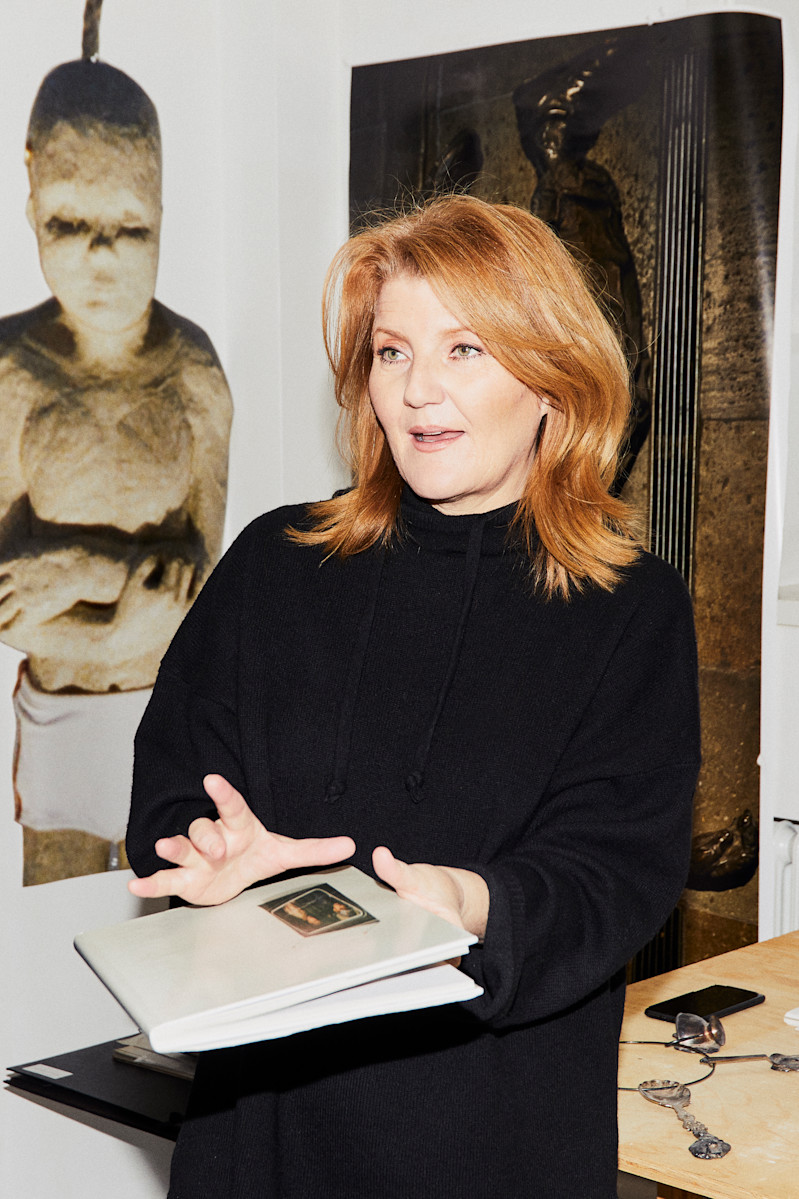
What did you pay attention to as a child? Are there any early observations you made that still resound with you as an adult?
— When I was about four years old I wished to be left alone. I was constantly interrupted. But I was never sure what exactly I was being interrupted from doing. I had a task, a mission, something to achieve. Mom said I could be irritable and unpredictable. I often wandered off. Once, I got lost in Täby Centrum, when we lived in Näsbypark. I wandered out into traffic, and an old lady picked me up. She drove a convertible, and we drove around looking for my house, because I didn’t know my last name. When I saw my mom, I ran straight to her, and I remember that I forgot to thank the old lady.
Most of all, I wanted to be left alone in our playroom, after we had moved into Stockholm. There were posters from Moderna Museet. On my father’s old Super-8 films, you can see us kids spinning around on Calder’s sculptures, all sporting crew cuts and red or blue hoods.
After we moved to Gothenburg, there was no more of that grandness. It was boring to hang around in galleries, and I remember that they all seemed to be in basements, with tiny, framed paintings on their walls.
At day care, they let us draw, and I have found some of my drawings. There was an old-fashioned teacher there called Carola. She wrote on my drawings: “tree,” “flower,” “grass.” On one of them, she wrote, “Charlotte wants to become an artist when she grows up.” I had drawn a man who was sitting on a stool under a bare lightbulb. It was clear to me from the start, it seems, that an artist’s life would be a barren, impoverished affair. It surprised me when I found the drawing as an adult, how I had been aware of that at such an early age.
I enrolled at the Royal Institute of Art, or Mejan, in 1983, and graduated from there in 1989. I took one year off to organize UNK-85, an arts festival on Skeppsholmen. This project was an attempt on my part to gain my bearings, so that I would be able to concentrate fully on my work afterwards. I had a solo show at the Leger gallery in Malmö, in 1989, right after leaving Mejan.
That show has always felt like a student exhibition to me, even though it was quite ambitious, and successful. I wondered what life was going to be for me: exhibiting every other year, and being grateful to have a gallery? I wasn’t ready, I had to keep learning, and even learn how to learn. At that point, I sent an application to the Royal College of Art in London, where I ended up at the Sculpture Department.

How was London different from Stockholm?
— London is a large, fragmented city, in physical, mental, and social terms alike, it was very difficult to get my head around the art scene. I tried to focus on spending time at school, and on working. It was an important year, during which I met some amazing teachers. They had an odd mixture of bad teachers who were permanently employed and incredibly good guest teachers and tutors. At the sculpting department, there was a peculiar war underway between the “stone carvers”, who worked in a more conventional tradition, and the “conceptuals”.
I was incredibly impressed to encounter people who actually carved rock; nobody at Mejan did that kind of thing. Tensions sometimes ran high between them and the conceptuals. "Are you even talking to him?" I was asked. The conceptualists despised the Vice-Chancellor of the Royal College, who held less-than-secret hopes of being knighted by Prince Charles. The architecture department, as rumour had it, was also influenced by Prince Charles, and by his ideas about London and ideal villages. I could never quite believe it. Our main teacher was a ruddy gentleman who was never there, and who made rather kitschy sculptures. One teacher, Terry, was nice, but everyone called him Terry Ten Percent. That’s what people were like: funny, vicious, and witty. A class struggle and a genre struggle were both playing out at once at Queen’s Gate in Kensington, where the sculpture department had been housed for more than a century. It was all quite charming, but also rather primitive. The bronze workshop was the size of a stable stall, and the bronze caster was a skilled, friendly Indian fellow who made do with some very limited means. Security was non-existent. I thought to myself that we were very privileged in Sweden, with our big workshops and our individual studios. It was an interesting environment, and the faculty, many of whom belonged to the new generation of sculptures that had sprung up just before the Young British Artists movement, included [Bill] Woodrow, [Richard] Deacon, [Lynn] Chadwick, and [Anish] Kapoor.
Would you call them late minimalists?
— No, they were narrative, they broke with minimalism. They were figurative. In the late 80s, before I was admitted to the RCA, critic Lars O Ericsson called my early sculptures hybrids, examples of what he called “impure” minimalism. I was working with a kind of abstract minimalism, with amorphous figurations that evaded representation, and using repetition in the minimalist fashion.
For me, it was important to meet with these artists, and to engage in those teacher-student discussions. I was steeped in the silent, romantic ideal of not talking about what you do. They challenged me, and I noticed that words had the power to liberate spaces within myself, and help me move on from insignificant matters.
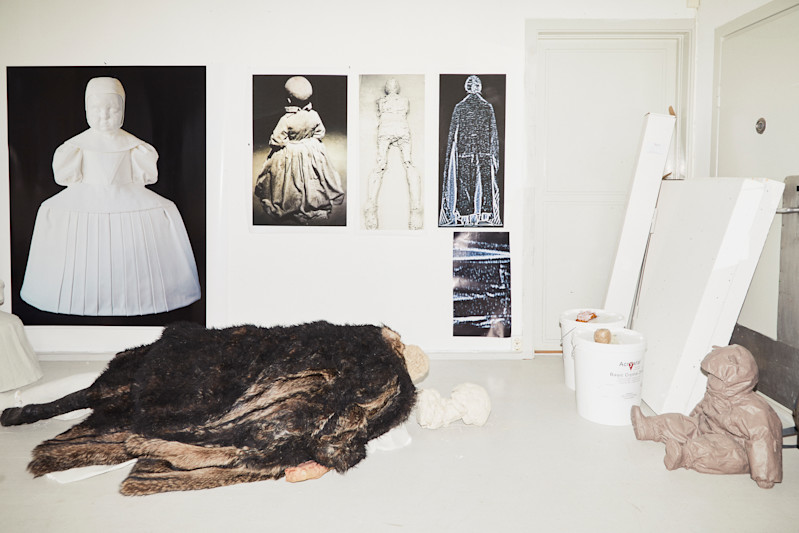
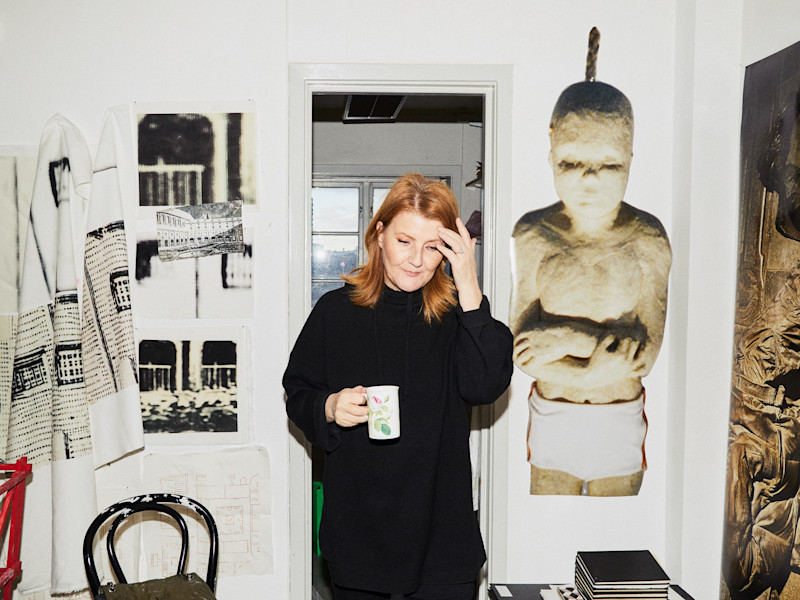
Are you better at those discussions now?
— In London, I learned that the language I use to think, read, and write doesn’t solely belong to me. It’s where we meet, it’s the actual game board. Where verbal language ends, image begins. Language generates images in me. Then, when I get to the point where I can’t make any more progress with words alone, image takes over. At that point, I subject the image to all manners of treatment, and I don’t mind playing rough. If I can disassemble an image into its constituent parts, it’s no good to me. But if I can’t take it apart, that means it is independent, out of my control. If I feel a sense of muteness or silence about an image, I have to pause before it and reflect.
Are you striving for something indivisible?
— Yes, that’s exactly it.
You have some indivisible entities: upside-downness, the positive and the negative, the child, the studio.
— Even the table. The studio as a location and self-portraits, like reports from the studio, a plotted position, like in navigation – a map. Something like: “Here I am!”
A bit like the playroom?
— Yes, a bit like that. In 1993, at Lunds konsthall, I placed a small desk, for children, with a waiting pad of paper and crayons, in the centre of a circle of 12 sculptures I had made from unfired clay. The clay fell vertically, in twelve places, resembling a large clock face.

It seems to me that you also relate to time as a concrete entity. Artists often try different things out, but you have a set of subjects that have kept you busy. The first thing to greet a visitor to your website, for example, is the oak tree, Dö för dig [Die for You]. That’s where you begin. And then, it’s as though you have a whole landscape to wander around in, while the decades pass by outside.
— Yes, that’s a beginning. But the beginning, at least to my mind, is Sprängning [Bursting] (1991), and later Dö för dig [Die for You] (1993), quite shortly thereafter. Two very important, very impactful works.Their execution was preceded by a great build-up of energy within me. Afterwards, I wandered around in that landscape, just like you said. I’ve always had a strong drive, propelling me forward. But now, I’m able to look back. It’s interesting to get older, and to have this archive, or library, that I can browse, and which is real.
It’s fascinating that something I’ve created can become real, and be approached as something new, or something to examine and scrutinize.
You can ask it questions?
— Yes, I can turn back, rather than always moving forward.
It’s a brave, different kind of approach. Daring to stop to find out what is in this room. Maybe the next thing is right there!
— Modernist time, in all its linearity and horizontality, is not the only kind of time. There is another kind, too, which is vertical, and upside down. Svindel [Vertigo], the underground, full-scale replica of my studio, at Wanås Konst, encourages me to “dig where you stand.” It takes patience, because I’d rather beat it, get lost, fly off. I’ve had to be quite strict with myself, restrain myself. At times, I’ve had to fight very hard to resist the impulse to leave, to be free. I have somebody who pulls me back, holds me still.
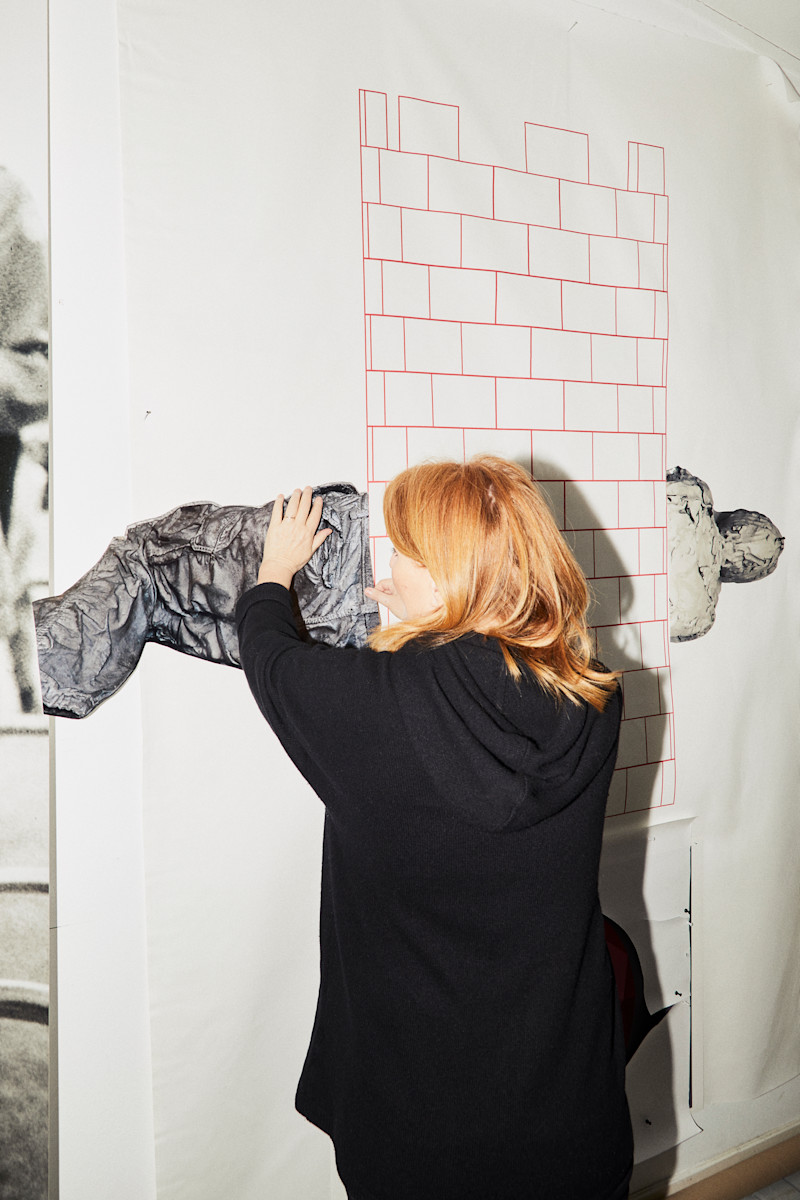
What is it that attracts you to the indivisible?
— I’m thinking of Tarkovsky, of what I read in his autobiography, Sculpting in Time. What he said about codes, especially in relation to symbols, is very interesting to me. I’ve never forgotten that. Birgitta Trotzig wrote about it, too. He used that word: indivisible. Codes are secret, but divisible. You can perform an analysis, and there is a solution. However, the symbol, Tarkovsky claims, is open, yet indivisible. You can’t crack it open, divide it, or kill it. It’s alive, and it isn’t secret; it’s open to all, with no hierarchies in play. I find it liberating to see things from outside the Western world, something different from all that progress and breaking with convention.
It also brings to mind the writer and philosopher Edouard Glissant, that which exists, but which can never be reached by the penetrating beam of light. The opaque as an image of resistance, and a metaphor he used in response to colonialism. Understanding as something other than an act of penetration, conquering, or taking possession.
— Foucault addresses this, too, in his thoughts on surveillance, which are still relevant in any discussion of democracy, globalization, and digitization. Everything is subject to penetration. Surveillance, transparency outweighing human privacy. It’s different with symbols; they’re accessible to all, to anybody who tries to see. It makes me think of the inviolable value of human beings. Even if you get killed, it can be unreal it’s real suffering, but the act in itself can be unreal or untrue. Despite being evil and having an effect, it remains untrue! This probably reflects some aspect of the Russian spirit, a transcendental reality above and beyond matter, that which conquers and lives on. The Holocaust is the big rock that I keep bashing my head against. This unacceptable, ungraspable event has pushed me over the edge, to the incomprehensible.
The idea of indivisibility is really a survival strategy. No other people can rival the Russian’s incredible knack for finding spaces within spaces. Public spaces there aren’t really public, you know. The public sphere is identical to the intimate, internal sphere. That’s a bit like the way I perceive your work, as an attempt to protect spaces.
— I brought that with me from childhood. I had an unwavering faith in my own spiritual power. If my thoughts could influence the world, wouldn’t it be awful if the terrible things I was thinking came true? That made me fear my own thoughts. I had such a strong sense that I possessed great mental power. For better or worse, I tested that conviction. I thought about how the playroom might catch fire, or about jumping out the window. I had speculative thoughts at a very early age.
Was it all an attempt to measure your own space?
— A teacher at RCA, Anthony Carter, told me: “You read space. You invent forms.” Another teacher, Mary Rose Sinn, said: “You have a passive, implicit pole, and an active, explicit pole, and you oscillate between them.” Time is my material. Before I understood that, I would sometimes sit there, staring at the paper, seemingly paralysed. Time provided motion, dynamics. This gave rise to different relations between the various elements and levels within each piece, but also between them. That’s why it’s so difficult when you’re young: you’re stuck inside a still, a single frame, viewing the future as an impenetrable mass of stillness. You gain further points of reference as time goes by.

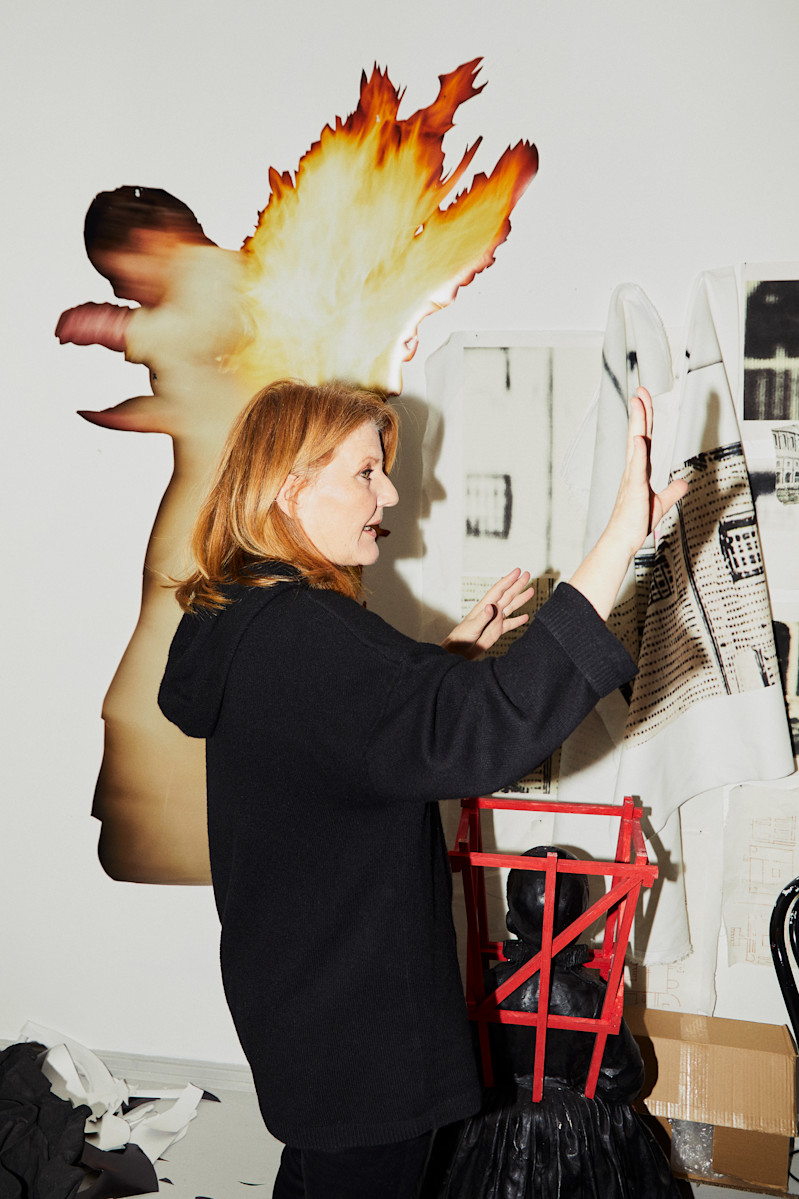
What will we encounter in your new exhibition?
— It’s difficult for me to talk about what is yet to be, but some things already exist, like a large table. On that table, I will present several works, a selection of miniatures and models. Again, relations and reflections on the past.
Is this the original, or the model?
— To me, the miniature is the original. I make the miniature afterwards. It’s kind of a reversed process.
When I start making a work, I don’t yet know if it will actually be made – not until afterwards, when I can see the results. The miniature confirms to me that the work exists.
I will also be showing a variation on Equilibrium, the seesaw, in a slightly smaller scale than the original. It will be installed in the hallway, and serve as a kind of footbridge between the earlier and the later works.
Sorry, but when you mentioned the seesaw, it made me think of Enno Hallek. I know he made one, too, and that he might have been a teacher of yours. He has stuck with certain, specific subject matters, too.
— Not so much him as Åke Pallarp – Marie-Louise used to work with him a lot. I participated in two of her films. I sang some phrases from Carmen, at a party at Mejan. She heard about this, and asked me to sing Ridi Pagliacco, a ridiculously famous tenor aria. I told her: “Honestly, I really can’t sing. It’s just something you’ve convinced yourself of.” But I went to see a singing tutor, and I sang to Marie-Louise a few weeks later. She sat there, on a stool, dumbfounded. Afterwards, she didn’t say a word. Three months later, she gave me a movie script and a part to play.
I wouldn’t just be singing; I would also be acting and dancing. Ernst-Hugo Järegård was the lead. Pallarp made the poster. The film premiered in 1987, and was titled Fadern, Sonen och Den Heliga Ande [The Father, the Son, and the Holy Ghost]. It was fun, and it marked the beginning of a friendship.
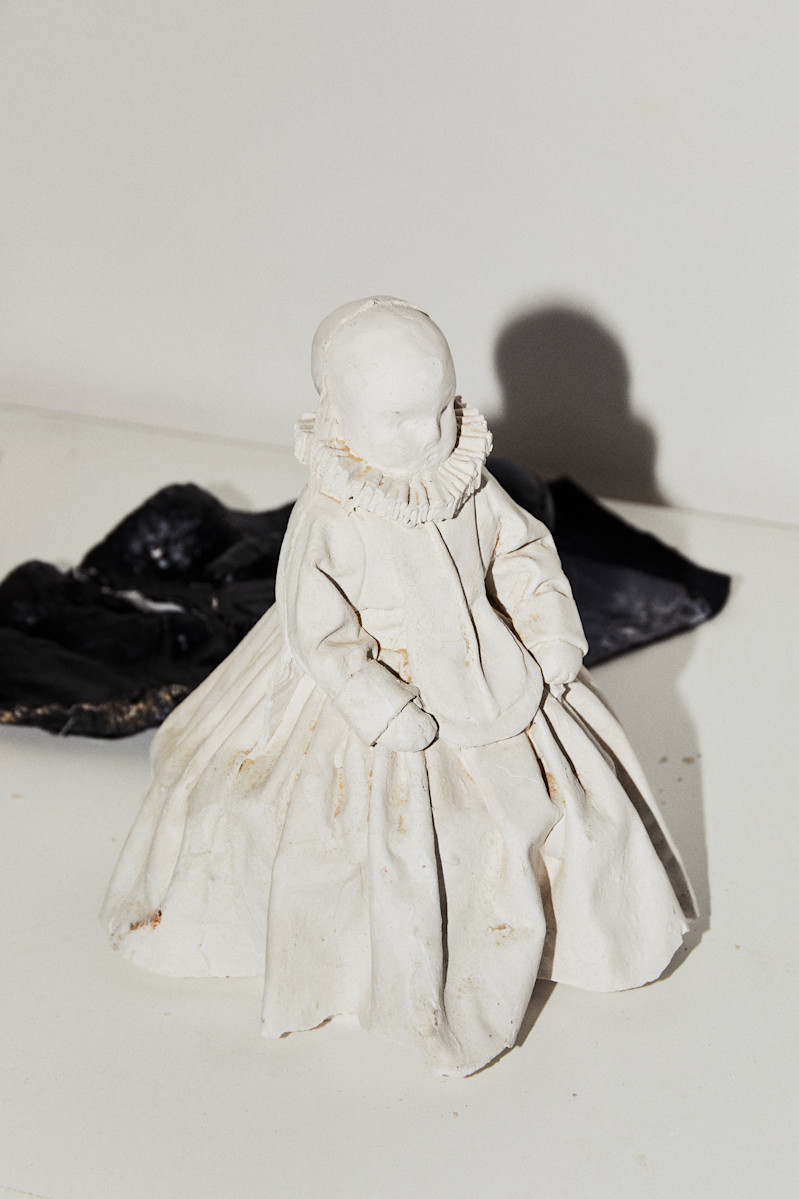
OK, but what about the exhibition. What will you be showing?
— Two or three films will be on the table, too.
Will they be projected?
— Yes. I like that the films have motion, although on a small scale. I viewed my first films as living stills, or breathing paintings. How? We’ll see. On some kind of small screen. The light in the space will pose a challenge.
Like a surrealist buffet?
— Yes, pretty much.
The worktable as self-portrait is a subject I have returned to many times before. My first film is titled Korsning [Crossroads] (1995), and was shot from a bird’s-eye view. It is projected through a mirror, making the screen appear to be hovering, horizontally, just above the floor. I am also thinking of an installation I made for my exhibition at Carl Eldh’s Ateljémuseum in 2013, Stenens mun [Mouth of the Rock].
In one of the rooms, I covered the windows, and filled the entire space with a single, large table surface. The table was a slatey grey colour, and I covered it with tools cast from black wax, which became like signs or letters. I titled the piece Osagd [Untold]. It was an attempt to formulate something that had been muted.
The works that constitute a starting point of sorts in this exhibition are a series of new reliefs. I’ve always been fascinated with reliefs, and the way they emerge from the surface, like awareness. You can follow my path in sculpture, from my first exhibition, Sprängning [Bursting], in which the large reliefs are negatives, in that their shape is recessed, unlike the broken fragments that have been strewn out over the floor. This contradicted expectations: the sculpture on the wall took the role of the image with its flat surface, while the painting, everything colourful, expressive, and broken, was spread out in the room as sculptures. The floor became like an expressive canvas of improvised chaos.
What material did you use for the reliefs?
— Ureol, which is a harder, more precise kind of plaster that was developed for industrial applications. It’s a rock-like material, which has a colour that’s a bit like foie gras. The reliefs were milled, just as would be done with a stone sculpture. It’s interesting to see new technology come into contact with stone carving through a solid material.
Textile, then, is that a new material for you?
— Not really. I had several of my early sculptures dressed in tailor-made fabric. Beholder was one of them. For the exhibition kastad/cast, I made a large tapestry with a printed drawing on bone-white velvet. Almost all my film installations have been projected onto screens. Now, I would like to develop the image further. I’m basing it on a construction drawing of one of my past works, Traum. It’s a large tower, cast in concrete.

Charlotte Gyllenhammar, Bed, 2022, Painted poplar wood, Edition of 3 + 2 AP, 140 x 122 x 7 cm
Another work, a new sculpture, consists of three equal parts that will form a pyramid, or a small mountain. I cut out a detail from a 15th century oil painting, and turned it into an enlarged relief. There are three of them, carved from poplar wood, and they will all be given a coat of red lacquer. The title is Rock Mass.
When I see these reliefs, they remind me of a globe they had at our school. You could feel the surface with your fingers and tell where there were mountains or valleys. Those figures are like landscapes. Are they sinking, or are they emerging?
— To me, the reliefs are a primal form. When I first began painting, it was as though the shapes emerged through the surface. They grew out from it as I glued stuff on. Some paintings even became like diving boards, jutting into the room. That’s the most decisive step I’ve ever taken in my work. I’ve also moved around within the tension between wall and surface, on the one hand, and floor and space, on the other. The reliefs become like frozen forms; emergences captured in mid-moment. Yes, it’s a lot like carving stone. The figure appears, but it is solid, indivisible, dense. It’s like suprematism, a fourth dimension that comes about when the body penetrates the surface between two dimensions.
What does film, moving image, mean in your work?
— Film is important to me, because it allows me to report to myself where I am currently at. I make my way into space. Something that I originally only imagined in my mind takes on a concrete form and becomes real. I couldn’t paint, for example, the canvas was like quicksand to me; offered me no firm resistance. I needed something to push away from. When I made film, I got to the point, I arrived at the image immediately. It was liberating; I could identify my position, and then make my way back into the room based on that. I work with images. Bildhuggare, another word for sculptor in Swedish, literally refers to carving in stone, i.e. making an image in stone. That word suits me.
What is idea, and what is matter, as you see it? Is there some conflict there?
— Everything can’t just be some abstract idea or other. It all begins with the technical aspects. You can find strength in dwelling on practical matters, they can help you see things. Practical work also involves meeting with others, collaborating with professionals like camera operators and craftspeople. When I see promise in something, I go out and test that idea. Sometimes, it crashes and burns, and sometimes, the resistance and the obstacles inspire me. I get to test my ideas. My ideas have to face the outside world. I’ve often been surprised at how concrete I can be. I take things very literally. My stubbornness sometimes gets me stuck, because I have to understand things my own way. When I was younger, this block could get quite serious. Sometimes, believing in your own foolishness can make all the difference. At least, that is, if you take it seriously.
In conclusion, how would you describe this exhibition?
— This exhibition has a kind of worktable, although this one is, well, a bit bigger. It’s a thinking table. What do I want to place on it, to be viewed? The act of watching has meant a lot to me. Leaving things be. Watching something, waiting, pausing, and only then launching your attack.
